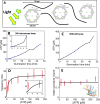Light-Powered Reactivation of Flagella and Contraction of Microtubule Networks: Toward Building an Artificial Cell
- PMID: 33761235
- PMCID: PMC8218302
- DOI: 10.1021/acssynbio.1c00071
Light-Powered Reactivation of Flagella and Contraction of Microtubule Networks: Toward Building an Artificial Cell
Abstract
Artificial systems capable of self-sustained movement with self-sufficient energy are of high interest with respect to the development of many challenging applications, including medical treatments, but also technical applications. The bottom-up assembly of such systems in the context of synthetic biology is still a challenging task. In this work, we demonstrate the biocompatibility and efficiency of an artificial light-driven energy module and a motility functional unit by integrating light-switchable photosynthetic vesicles with demembranated flagella. The flagellar propulsion is coupled to the beating frequency, and dynamic ATP synthesis in response to illumination allows us to control beating frequency of flagella in a light-dependent manner. In addition, we verified the functionality of light-powered synthetic vesicles in in vitro motility assays by encapsulating microtubules assembled with force-generating kinesin-1 motors and the energy module to investigate the dynamics of a contractile filamentous network in cell-like compartments by optical stimulation. Integration of this photosynthetic system with various biological building blocks such as cytoskeletal filaments and molecular motors may contribute to the bottom-up synthesis of artificial cells that are able to undergo motor-driven morphological deformations and exhibit directional motion in a light-controllable fashion.
Conflict of interest statement
The authors declare no competing financial interest.
Figures








Similar articles
-
Reconstitution of flagellar sliding.Methods Enzymol. 2013;524:343-69. doi: 10.1016/B978-0-12-397945-2.00019-6. Methods Enzymol. 2013. PMID: 23498749
-
How signals of calcium ions initiate the beats of cilia and flagella.Biosystems. 2019 Aug;182:42-51. doi: 10.1016/j.biosystems.2019.103981. Epub 2019 Jun 13. Biosystems. 2019. PMID: 31202860
-
A solid-state control system for dynein-based ciliary/flagellar motility.J Cell Biol. 2013 Apr 15;201(2):173-5. doi: 10.1083/jcb.201302077. Epub 2013 Apr 8. J Cell Biol. 2013. PMID: 23569213 Free PMC article.
-
Intraflagellar transport motors in cilia: moving along the cell's antenna.J Cell Biol. 2008 Jan 14;180(1):23-9. doi: 10.1083/jcb.200709133. Epub 2008 Jan 7. J Cell Biol. 2008. PMID: 18180368 Free PMC article. Review.
-
Intraflagellar transport.Annu Rev Cell Dev Biol. 2003;19:423-43. doi: 10.1146/annurev.cellbio.19.111401.091318. Annu Rev Cell Dev Biol. 2003. PMID: 14570576 Review.
Cited by
-
Flagellum-driven cargoes: Influence of cargo size and the flagellum-cargo attachment geometry.PLoS One. 2023 Mar 10;18(3):e0279940. doi: 10.1371/journal.pone.0279940. eCollection 2023. PLoS One. 2023. PMID: 36897856 Free PMC article.
-
Synthetic Cell as a Platform for Understanding Membrane-Membrane Interactions.Membranes (Basel). 2021 Nov 23;11(12):912. doi: 10.3390/membranes11120912. Membranes (Basel). 2021. PMID: 34940413 Free PMC article. Review.
-
Nano/Micromotors in Active Matter.Micromachines (Basel). 2022 Feb 17;13(2):307. doi: 10.3390/mi13020307. Micromachines (Basel). 2022. PMID: 35208431 Free PMC article. Review.
-
Towards Synthetic Cells with Self-Producing Energy.Chempluschem. 2024 Oct;89(10):e202400138. doi: 10.1002/cplu.202400138. Epub 2024 Jul 31. Chempluschem. 2024. PMID: 38866722 Review.
-
Thermally Driven Dynamic Behaviors in Polymeric Vesicles.Small. 2025 Aug;21(33):e2411220. doi: 10.1002/smll.202411220. Epub 2025 Mar 5. Small. 2025. PMID: 40042428 Free PMC article.
References
Publication types
MeSH terms
Substances
LinkOut - more resources
Full Text Sources
Other Literature Sources

